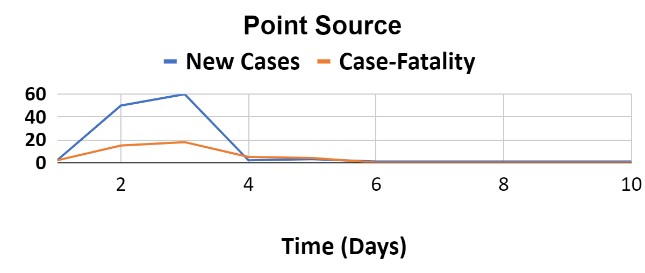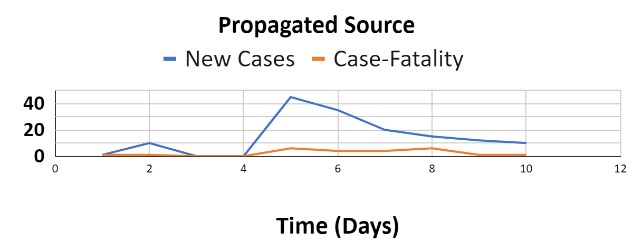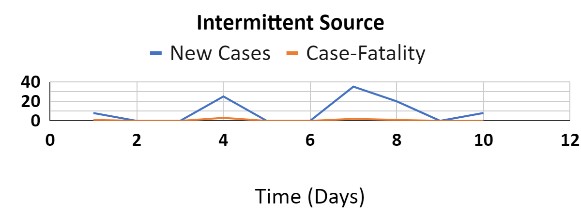
Epidemic Curves: A Simple Investigation Tool
Epidemic Disease of Animal
The veterinarians are called upon to investigate animal disease outbreaks. Here are some important tips to handle an epidemic:
The disease is called epidemic when the occurrence of the disease is more than average occurrence in a time frame. Some diseases are endemic, which means present in the population a low average and such diseases also become epidemic if the incidence crosses the normal threshold. For example, if the incidence of abortion normally is 1% per year, when it crosses this limit it would be classified as an epidemic.
While attending epidemics I have followed some basic principles.
- Encourage correct disease reporting: This is the basic requirement of any epidemiology investigation. The officials who report the disease occurrence correctly should be rewarded and encouraged. Hiding a disease ultimately means allowing the disease to multiply in the population.
- Do not try to find out the specific cause to start with: Many investigators do this mistake, spend more time and energy in the investigation of the precise cause. Epidemics are like fires when these occur you first attempt to extinguish the fire and its spread. The same holds good here. You should try to find out how it is spreading and put a barrier to transmission.
- Thinning out: This is the same as ‘social distancing’ in the human disease epidemic. The principle here is that transmission is facilitated when the density of the population is more. This is, of course, true in case of highly contagious diseases. But this you will find out after analysis of the data. Hence irrespective, I ask the farmer to separate out all animals.
- Isolate diseased animals: If space permits, isolate all sick animals. It also facilitates treatment logistics.
- Identify the first case and the starting date: This is important to know to understand the nature of transmission and the rapidity of the spread. Since the farmer would report a case only when there are signs, this should not be taken as the date of contact with the contagion or the causal factor. The incubation time should be added.
- Analyze the data and create a back-of-the-envelope epidemic curve: Here I mean rapidly collect disease and mortality patterns. There are two ways to display disease occurrence data; new cases Vs time and cumulative cases Vs time and mortality data. Many epidemiologists use the term ‘case fatality rate’ instead of mortality rate, as the true definition of mortality is a number of cases dead out of susceptible the population, whereas case fatality rate means a number of cases died out a number of cases suffering from the same disease.
- Stratification of the cases into categories: The next step in organizing the data is stratification by considering sex (especially in goat and sheep flocks), age and if possible, breeding status (pregnant and open). These curves would show the high-risk class. In case you are dealing with a widespread epidemic, in that case, even stratification by geographic location, such as block or district will also show how the disease has spread.
The plot on X-axis the time, which could be hours, days or weeks depending upon the nature of the disease outbreak. If the disease outbreak persists for a long time, in that case, weeks or months could be the unit on X-axis. On Y-axis plot the number of cases. Based on the curve type the nature of transmission can be predicted.
Following are different types of curves:
Pont-source: From the curve, it can be deduced that the epidemic is due to a common source as there is a spurt in the cases followed by tapering. The case- fatality follows the morbidity curve. Look for common source cause (feed, fodder, water). The first response changes in the source immediately. Thinning might not be helpful as it is not contagious. In diseases where the spread is animal-to-animal con tact and aerosol as the media of transmission the epidemic curve will be like a linear curve.


Continuous Source: The occurrence of new case s is for a prolonged period which suggests that the disease is contagious and spreading in the population at the same rate. The low case-fatality rate suggests that it is low-grade self-limiting infection but progressing due to contact. Here thinning would be helpful. In such cases stratification of the data is highly recommended to know high-risk group.

Propagated Source: In such epidemics, initially very few cases are reported, followed by a lull period and then there is a spur of the new cases. A low case fatality rate suggest that the infection is not very virulent. Isolation of the new cases should be recommended. Usually such outbreaks have transmission through vehicles, such as needle transmission or vectors. In this case also stratification of the data for morbidity and case-fatality is helpful.

Intermittent Curve: The new cases occurrent is intermittent suggestive of intermittent nature of transmission. In this case too stratification of the data for various factors should be carried out.

Made out epidemic:
I came across an interesting outbreak in a goat flock. The owners were a group of retired teachers who as a group established a farm near Thane. For nearly one year everything looked good. Suddenly there were reports of mortality. Every alternate day or in a week one or two deaths were reported. Local veterinarians tried to help out with the administration of antibiotics, vitamins, minerals, etc., but mortality did not come under control. On their request, I visited the farm for investigations. The farm infrastructure was food, very clean, with adequate feed and fodder. I asked the farm staff to show me any sick animal, but the answer was no sick animal on that day. I started building the epidemic curve and found out that on no occasion mortality was more than 2 animals. Stratification of the data showed that only adult males were reported dead and no mortality in young animals. When I asked the farm staff about symptoms, the reply was always sudden death. I asked the owners if in any case post-mortem was conducted, the reply was none and the reason offered was that since the death occurred during mid-night for fear of transmission the animal was disposed of before the arrival of the owners on the farm. At this stage, I became suspicious and took the Manager aside and threatened him that I would hand over him to police if he did not tell the correct story. Finally, it came out that since the owners were residing in Mumbai and would reach the farm only after 12 noon, the Manager was selling off one or two ready-to-market bucks to make quick money.
